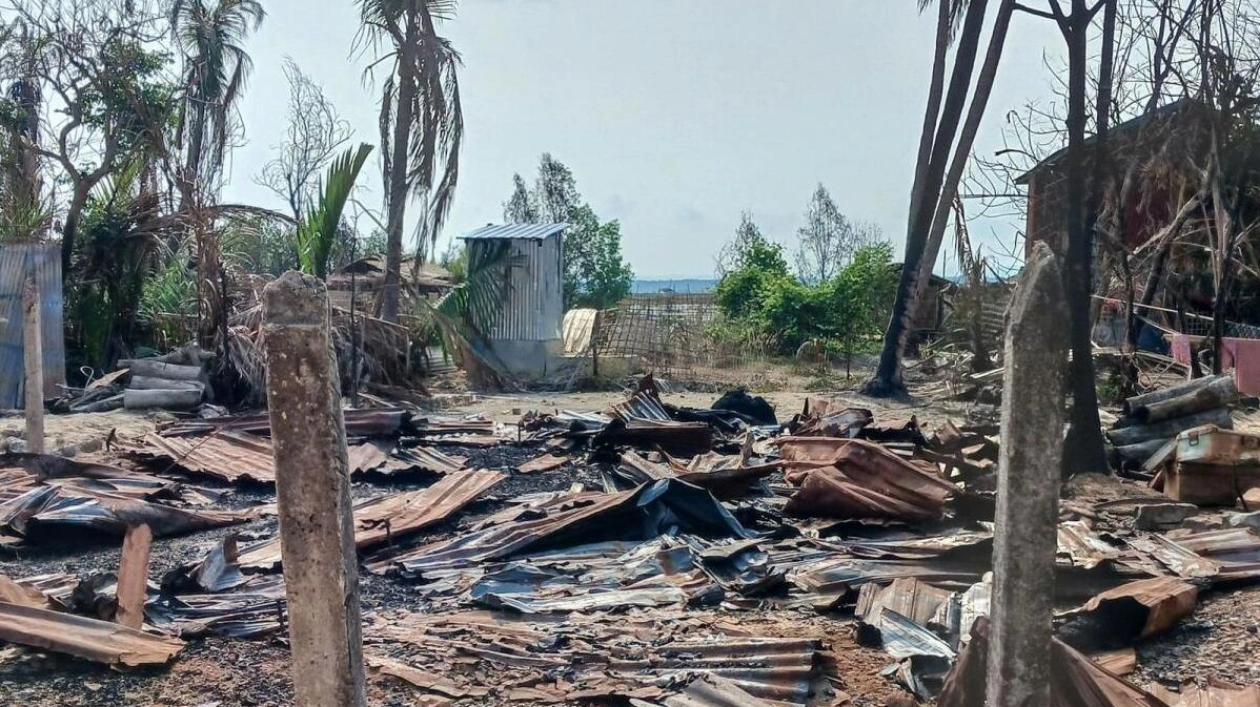Saifur Rahman awoke to piercing screams. In the enveloping darkness, the air was thick with the stench of fuel. Flames roared in the distance. The town of Buthidaung in Rakhine state, Myanmar's largest settlement of minority Rohingya, was engulfed in flames and under siege.
"All I could see was fire," recounted the 30-year-old Rohingya. "We knew something terrible might happen, but never expected this." After the fires died down, the riverside town near Myanmar’s western border with Bangladesh lay in ruins, leaving thousands of Rohingya homeless. Initial estimates suggest at least 45 Rohingya perished during the attack and its immediate aftermath, according to a senior United Nations official. The attack at around 10pm on May 17 marked another episode of violence against the Rohingya, Myanmar’s predominantly Muslim ethnic minority group, which endured what the UN termed "textbook ethnic cleansing" by the Buddhist-majority country's military in 2017.
In that year, the military orchestrated the killing of an estimated 10,000 Rohingya, forcing more than 700,000 to flee into neighboring Bangladesh, as per the UN. Since then, clashes have erupted between junta troops and the powerful Arakan Army ethnic militia in Rakhine state, with hostilities escalating in recent months as the rebels claimed significant victories. Reuters interviewed 12 Buthidaung residents via phone and near refugee camps in Bangladesh, and analyzed satellite imagery of the area before and after the fires to reconstruct the events of May 17. The news agency discovered that the party directly responsible for the May arson attacks was not the military but the Arakan Army, primarily composed of ethnic Rakhine, the Buddhist majority in Rakhine state.
Like numerous other ethnic armies in the country, the Arakan Army, frequently referred to as the AA, has been embroiled in a brutal civil war against the junta since it ousted Myanmar's civilian-led government in a 2021 coup. Established in 2009, the Arakan Army has persistently fought the Myanmar state for the "liberation" of Rakhine and the establishment of an autonomous enclave. James Rodehaver, head of the UN office on human rights for Myanmar, stated that "every indication" from their interviews with residents pointed to the Arakan Army's responsibility. He noted that residents described Arakan Army soldiers armed with petrol-soaked sticks setting fire to buildings, and that other potential "malefactors" like the junta were not in the area at the time.
His comments mark the first time the UN has implicated the Arakan Army for the blaze. Their investigation was ongoing, he added. The findings by the UN and Reuters contradict statements made to Reuters by Arakan Army spokesman Khine Thu Kha on May 19, who attributed the burning of Buthidaung to a junta airstrike before the militia took control of the town. Rodehaver informed Reuters there was "no indication at all" of airstrikes causing the fires and no reports of large explosions typically associated with such attacks. Nathan Ruser, an analyst at the Australian Strategic Policy Institute think-tank, reviewed imagery of Buthidaung supplied by satellite firm Planet Labs before and after the blazes and concluded they matched a ground campaign of arson attacks by the Arakan Army in northern Rakhine that he has closely studied.
"But it's nearly impossible without on-the-ground investigation to fully rule out the possibility of airstrikes (by the junta) in the town itself," Ruser noted. Responding to Reuters’ findings, Khine Thu Kha called them "groundless accusations" and asserted that the rebel group had assisted civilians without regard to religion. "We, Arakan Army, did not burn anything," he declared. "There isn’t an innocent civilian who died because of our troops." Myanmar’s information ministry, in response to Reuters inquiries, stated that the military did not ignite communal tensions or set fire to any parts of Buthidaung while it was under their control.
It described the military as a "legally recognised armed organisation… conducting disciplined activities aimed at fully protecting and defending our country", and blamed the incidents on the Arakan Army, which it characterised as engaging in "terrorism". International watchdogs like Amnesty, as well as Rohingya activist groups, have previously accused the Arakan Army of abuses such as abductions. It has consistently denied these allegations. Reuters also uncovered that the junta exacerbated the recent conflict between the Rakhine majority in the state and Rohingya by forcibly recruiting members of the Muslim minority, whom they had previously sought to eradicate, to burn down their Rakhine neighbors' homes in Buthidaung earlier this year.
Two Rohingya men from Rakhine revealed to Reuters that they had been kidnapped and conscripted this year by the junta, which is grappling with a severe manpower shortage following major battlefield defeats in the civil war. Three other former Rohingya residents of Buthidaung claimed they had witnessed local Rohingya being forcibly conscripted and deployed to burn the properties of Rakhine residents who had fled. Some residents spoke on condition that only part of their names be used due to fear of retribution. Ethnic Rakhine participated in the purge of the Rohingya in 2017, as previously reported by Reuters.
The military's strategy of forcibly recruiting "thousands" of Rohingya is intended to foment communal divisions, according to Thomas Andrews, the UN special rapporteur on the situation of human rights in Myanmar. "For Rohingya people, oppressed, scapegoated, exploited, and caught between warring parties, the situation echoes the lead-up to the genocidal violence of 2016 and 2017," Andrews stated. The violence in Buthidaung commenced earlier this year, when clashes between Arakan Army and junta troops approached the town. Many Rakhine locals departed in March, according to five residents and a humanitarian official briefed on the situation. The Buthidaung area had a population of around 55,000, according to the last census held in 2014.
This figure excludes the Rohingya — considered illegal immigrants by both the deposed civilian government and the junta, despite their long-standing presence in Myanmar — who numbered more than 100,000, according to two Rohingya activists. The forced recruitment of Rohingya in Buthidaung dates back to at least March, when 24-year-old Ali recounted soldiers barging into his house around midnight. They rounded up two dozen Rohingya that night, who were informed by the soldiers that "youths would have to take up arms to free the country from terrorism", he said. Another Rohingya man from Buthidaung also disclosed that he was conscripted by the Arakan Army to combat the junta.
A 15-year-old Rohingya boy separately told Reuters that he was abducted by a military-aligned Rohingya insurgent group from a refugee camp in neighboring Bangladesh in April and transported to Rakhine state to fight a "jihad". Ali detailed being taken to a military training camp where he was instructed in weapon use. Eight days after his abduction, he was tasked with collecting water and seized the opportunity to escape. He now resides in Bangladesh, having fled Myanmar on foot and by boat. The following month, military officers began coercing Ali's fellow Rohingya conscripts into burning and looting their Buddhist neighbors' homes, according to three former Buthidaung residents who witnessed the arson.
"'These Rakhine people killed your people and burned your houses in 2017'," recounted Sawyed, who lived in the town's northeast, recalling what soldiers told Rohingya conscripts. "'Now, it is time for revenge.'" "Community members and elders attempted to halt them," another eyewitness added. "But they were unstoppable." Satellite imagery from Planet taken in mid-April reveals extensive sections of southern and western Buthidaung scorched by fires between April 13 and April 16, when Medecins Sans Frontières reported its office adjoining the main highway cutting through town had also been burned down. The medical charity did not publicly attribute blame for the incident that occurred on April 15.
The MSF stated in a statement to Reuters that it had been compelled to suspend its activities in Buthidaung due to escalating conflict and that "communities are being left with no options for medical care". Approximately 1,500 buildings in Buthidaung were destroyed during the April arson spree, according to a count from satellite imagery by Data for Myanmar, an independent research group. Andrews, the UN expert, told Reuters that arson attacks on civilian property and humanitarian agencies "may also constitute crimes under international law" by both sides and called for an International Criminal Court investigation to ensure "all perpetrators (are) held accountable, regardless of their affiliation". The ICC did not respond to a request for comment.
The court in 2019 initiated an investigation into alleged crimes against humanity targeting the Rohingya, but the scope of the probe is limited to offenses where at least one element was committed on the territory of Bangladesh. Aung Chay, a 27-year-old ethnic Rakhine schoolteacher from Buthidaung whose house was burned down, said he had lived peacefully with the Rohingya. However, "they deliberately torched our houses by joining the junta", he claimed. Numerous areas near Buthidaung were set ablaze between April 15 and May 18, according to an analysis of satellite imagery conducted by ASPI's Ruser. At least two smaller Rohingya settlements near Buthidaung were razed in May as the Arakan Army advanced through the countryside, according to a Reuters analysis of satellite imagery cross-referenced against locations that the militia announced it had captured.
The UN's Rodehaver stated their analysis of the burning of Rohingya settlements in the days preceding the arson in Buthidaung suggested targeted destruction, with only Muslim areas set alight. A similar "very strategic set of burnings" was observed during the arson of Buthidaung, he noted. Junta troops in Buthidaung withdrew by May 15, according to four Buthidaung residents, raising hopes that there would not be a battle for control of the town. "At first, we thought the AA wouldn't trouble us because there was no need to fight in the town," said Sawyed. "So, we prepared ourselves to make friends."
Around 6.30pm on May 17, three Rohingya elders encountered Arakan Army fighters on the outskirts of a nearby village. The Arakan Army advised residents not to leave Buthidaung before morning, according to two individuals familiar with the matter. However, at least some Rohingya were separately instructed to depart immediately, according to the UN's Rodehaver, who mentioned that the militia had issued similar warnings before torching other settlements they advanced on. But just a few hours later, Arakan Army soldiers — recognizable by their uniforms and the Rakhine dialect they spoke — marched into Buthidaung, according to five Rohingya residents.
At approximately 9.30pm, a 24-year-old shopkeeper who identified himself by what he claimed was his nickname of Nuru observed AA troops in a northern neighborhood. Chaos ensued shortly after. "Many people fled their homes, warning us that the AA were coming and burning houses," he recounted. At around the same time, 38-year-old grocer Zaw Win noticed houses ablaze in the southern part of the town. "There was fire all around us — from the north, east, and south," he described. "They were setting fires to encircle us." Rodehaver explained that the Arakan Army employed burning sticks soaked in petrol that were thrown to ignite and spread blazes. Similar tactics were employed against the Rohingya in 2017, as previously reported by Reuters.
The area around Buthidaung's main hospital, where dozens of Rohingya had sought refuge, was also set alight by Arakan Army fighters, according to two eyewitnesses. "I heard the people yelling and begging for help," one of them said, depicting a house filled with people that was engulfed in flames. The neighborhoods identified by Nuru, Zaw Win, and other eyewitnesses correspond to the areas devastated by fire in satellite images reviewed by Reuters. Many of Buthidaung's Rohingya fled west along the main road, heading towards the coastal settlement of Maungdaw.
Even away from the fires, the peril was not abated. By midnight, a crowd fleeing towards Maungdaw congregated in the fields surrounding Buthidaung prison. However, they were obstructed by Arakan Army soldiers, some of whom fired into the air, sparking further chaos, according to three eyewitnesses. Saifur Rahman, his wife Jamila, and their children, aged five and two, managed to escape the melee, but only after his brother had been killed in the commotion, he recounted. "The town was reduced to ashes before my eyes," Jamila lamented. "It was no less than hell on earth."
The family embarked on a six-day journey on foot to Bangladesh. Buthidaung is separated from coastal areas bordering Bangladesh by a mountain range, and Rahman said his family subsisted on leaves and coconuts. "I only knew that I needed to protect my daughters and my wife," he said in an interview near the Bangladesh town of Cox's Bazar, where sprawling refugee camps are situated. Once receptive to displaced Rohingya, Dhaka has declared it will no longer welcome refugees from its war-torn neighbor, leaving Rahman apprehensive about deportation. The Bangladesh interior and foreign ministries did not respond to requests for comment.
"Nothing is left there," Rahman stated. "They will kill us."






